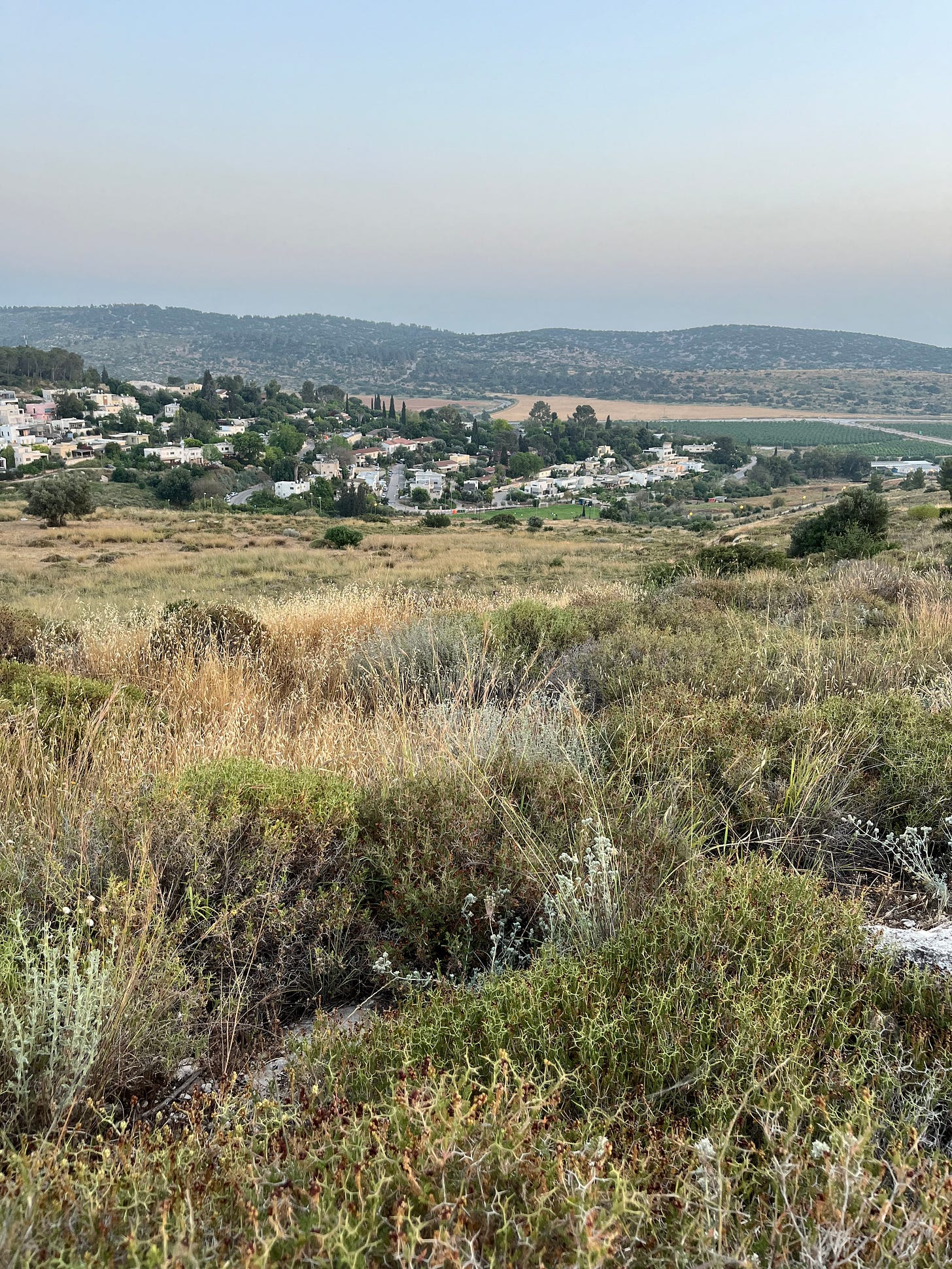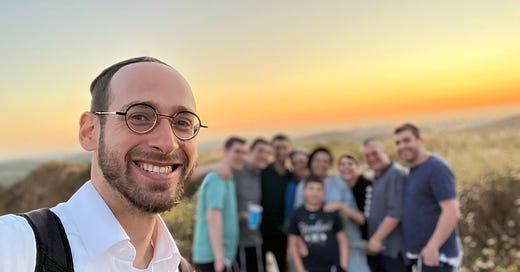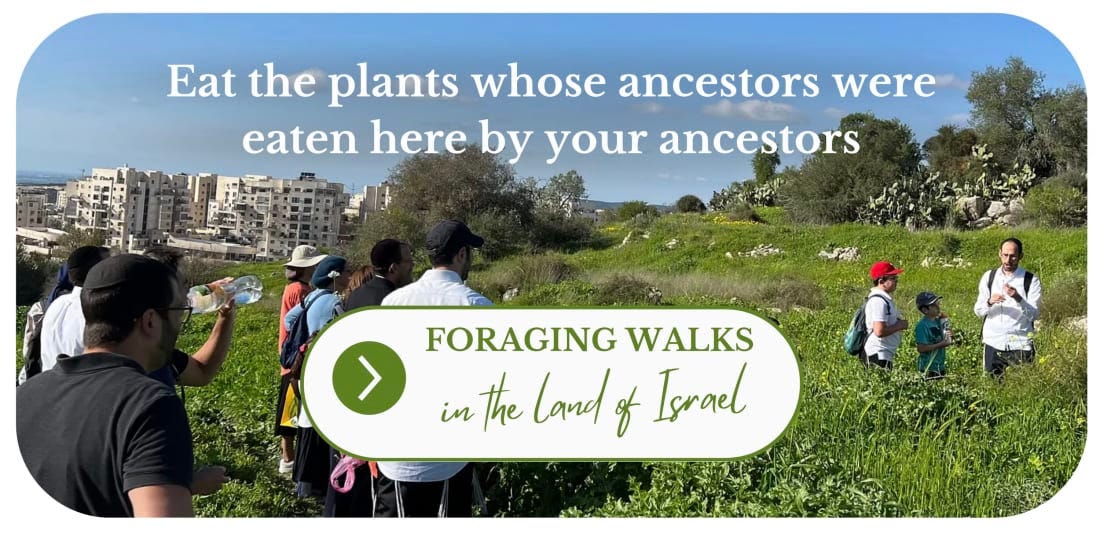6 Ways Foraging Walks Made Our Pesach Come Alive
Pictures, videos, and stories from Israel's natural world last week.
Dear Healthy Jew,
This Pesach, over 130 Jews joined me on foraging walks in Israel’s nature world. During 7 walks in 4 different locations in the Shfelah region of Israel, we tasted Pesach living - literally - in the heartland of Israel, the healthy body of the Jewish people.
Here are 6 ways Pesach came alive on our foraging walks:
1. Bitter Herbs That Are Actually Bitter
On Seder night, Jews all over the world eat maror (bitter herbs) to remember our bitter slavery in Egypt. As I explained in these pages before Pesach, this isn’t a cute reminder on our phones - ping! - but the way we relive slavery every year.
Nowadays most people eat romaine lettuce for maror. But romaine lettuce, mind you, isn’t very bitter.
Bitter herbs were’s always so not bitter. Back in the day, Jews in Israel gathered the wild lettuce that grows in this season all over Israel, and is quite bitter indeed. Its milky sap even has a small amount of opioids, making wild lettuce tea a great calming herb. If you make it strong enough, it might even give you a buzz for several moments. (But not too strong - that can give you a headache, and maybe even be dangerous.)
2. Bundles of Aizov
On our final night in Egypt, God instructed us to paint our doorposts with the blood of the sacrificial lamb. He also said what brush to use: a bundle of aizov.
What’s aizov? We don’t know for sure, but tradition tells it’s the plant that the locals call za’atar, the centerpiece of a spice mixture found in most Middle Eastern kitchens (including ours). The Rambam (Maimonides) already mentioned the aizov’s culinary uses.1
My Bedouin friends tell me that za’atar is also a medicinal herb and that its aromatic tea helps all sorts of common respiratory and digestive ailments.2
I drink za’atar tea all the time. Hey, come to think of it, I even had a cup on Seder night before the afikoman.
3. Up to Jerusalem
The Torah instructs to visit the Temple in Jerusalem on each of the Jewish calendar’s 3 biblical festivals. For almost a thousand years, millions of Jews trudged along the trails of Israel’s Shfelah region (where most Temple-going Jews lived) until they reached the mountain passes that now host Route 375. Remnants of the old Roman-era road still dot the highway.
This Pesach we walked along those ancient paths, eating the same plants whose ancestors were eaten here by our ancestors as they marched up to Jerusalem. We even stopped to rest at Roman mile-markers.
4. From Egypt to Israel
Why did we leave Egypt? As I’ve explained at length in these pages, and in my new book, Land of Health: Israel’s War for Wellness, the point of it all was to settle in the land of Israel.
Yet for around 400 years after Yehoshua’s (Joshua) initial conquest, most of the fertile Shfelah remained in the hands of hostile Philistine tribes, until a certain youth David threw a stone at the giant Goliath in the Elah Valley. I recently shared with you the story and message of David, and its relevance for our troubled times. Here you can see how we experienced the story this week on a hilltop overlooking the Elah Valley.
5. God’s Grain
The Torah instructs to offer our first harvest in God’s Temple, putting God first when we work the land for our livelihood. Even today when we don’t have a Temple to perform this special ceremony, we don’t eat newly grown grain until after the day we’re supposed to bring the offering: the second day of Pesach.
So when we’re out foraging and see the wild barley and oats proliferating everywhere, we feel how these days we should be cutting them in God’s honor, with praise and gratitude.

6. Making Sense of Kitniyos
Ashkenazic custom is to refrain from eating kitniyos, a broad class of foods that include most legumes and seeds. Why? Because potentially chometz grains grow close to these legumes, and they can get mixed up in the harvest.
Lots of folks complain that the kitniyos custom seems archaic and detached from reality. Come on, Jews never had basic quality control?
On foraging walks everywhere in Israel, we come to appreciate this custom whenever we see mustard - an extremely common legume - growing together with wild barley and oats. It’s hard to see how any commercial harvest of one won’t catch some of the other.
So on our Pesach foraging walks, our Sephardi brothers and sisters (who don’t have this custom) tasted the mustard for all of us.

Now Pesach has gone, and with it went all the quandaries of new harvests and kitniyos.
Yet Israel’s natural world still waits for you to taste its late-spring gifts: mustard, wild lettuce, milk thistle seeds, nettle seeds, fennel stalks, bristly hollyhock flowers, and much more. Soon she will be offering her summer treats, mostly fruits: carob, Elah, buckthorn, cactus, fennel, and much more.
So next time you’re in the neighborhood, drop me a line and we’ll go out foraging! I can be reached by phone or Whatsapp at (972) 53-763-0869, or email to scnaiman@healthyjew.org.
Thank you for reading Healthy Jew.
Here are 2 great paths to continue the journey:
Also check out this intro and index to explore hundreds of posts about our 3 Healthy Jew topics: Wellness with Wisdom, Land of Life (Israel), and Sensible Spirituality.
Finally, always feel free to reach out here with any comments, questions, or complaints:
I look forward to hearing from you!
Be well,
Rabbi Shmuel Chaim Naiman
Hilchos Parah Adumah 3:2
Learn more about za’atar here: https://he.wikipedia.org/wiki/אזוב_מצוי







